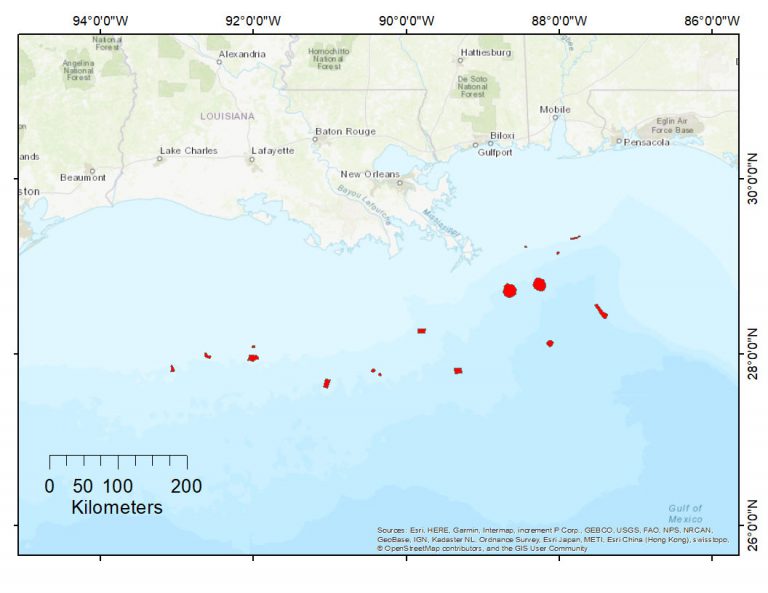Full Title: Population Connectivity of Deepwater Corals in the Northern Gulf of Mexico
This project determined from where the corals in different mesophotic (50-150 m) and deepwater (150-2400 m) populations in the Gulf of Mexico originated, which is critical information for conserving and restoring these important habitats that were damaged by the Deepwater Horizon (DWH) oil spill.

The Team: Santiago Herrera (Lead Investigator, Lehigh University, santiago.herrera@lehigh.edu), Andrea Quattrini (Harvey Mudd College), Annalisa Bracco (Georgia Institute of Technology), and Peter Etnoyer (NOAA)
Technical Monitor: Janessy Frometa (janessy.frometa@noaa.gov) and Cheryl Morrison (cmorrison@usgs.gov)
Federal Program Officer/Point of Contact: Frank Parker (frank.parker@noaa.gov)/
This project began in June 2017 and ended in November 2021.
Award Amount: $1,338,193
Why it matters: Deepwater corals provide habitat for diverse and abundant invertebrate and fish communities, including refuge and prey for commercially valuable fisheries. These extremely slow-growing communities are becoming increasingly vulnerable to anthropogenic threats from increased ocean temperatures, fishing activities, and oil and gas exploration. Understanding how deepwater corals are genetically connected is critical to their conservation and restoration.
What the team did: This project focused on four species of mesophotic and deepwater corals that were directly impacted by the DWH oil spill. The project aimed to help guide management decisions by addressing crucial gaps in the understanding of the processes that influence population connectivity patterns of habitat-forming deepwater and mesophotic corals. The team worked to achieve this by combining field sampling, population genomic analyses, and physical oceanographic modeling to 1) define spatial scales of coral populations, 2) infer directionality and relative rate of genetic exchange among the coral populations, and 3) integrate predictive models of larval dispersal with genetic data to estimate dispersal distances and connectivity patterns.
Summary of Outcome: This project filled crucial gaps in the understanding of the processes that shape population connectivity patterns in deepwater and mesophotic corals in the GoM. The work focused on species directly impacted by the Deepwater Horizon oil spill. The project targeted coral species that live at three depth ranges 1) Swiftia exserta and Muricea pendula (continental shelf edge/mesophotic: 50-150 m), Callogorgia delta (upper continental slope: 400-1100 m), and Paramuricea biscaya (lower continental slope: 1300-2400 m). The team quantified population connectivity in deepwater coral species through the integration of field sampling, state-of-the-art population genomic analyses, and physical oceanographic modeling approaches. The team worked closely with managers to plan research activities and disseminate results through interim reports and a synthesis workshop. This project achieved the most comprehensive study of deep-sea population connectivity to date in the Gulf of Mexico, serving as a model for future seascape genomic connectivity studies.
Other Resources
Herrera S. (2021) Salting-out protocol for extracting HMW genomic DNA from frozen octocorals dx.doi.org/10.17504/protocols.io.bypypvpw
- Genomics Guides Restoration of Coral Affected by Deepwater Horizon Oil Spill (video)
- RESTORE Deepwater Corals (youtube videos)
- Unlocking the mysteries of deepwater corals to restore the Gulf of Mexico, EurekAlert!, July 12, 2017
- Unlocking the mysteries of deepwater corals to restore the Gulf of Mexico, Phys.org, July 12, 2017
- RESTORE Feature Story: Students Translate Deep-Ocean Science into Kids’ Books, Feb. 18, 2022
Scientists discover unusual new bacteria in deep-sea coral, 17 Nov 2024
 Official websites use.gov
A .gov website belongs to an official government organization in the United States.
Official websites use.gov
A .gov website belongs to an official government organization in the United States.
 Secure .gov websites use HTTPS
A lock or https:// means you’ve safely connected to the .gov website. Share sensitive information only on official, secure websites.
Secure .gov websites use HTTPS
A lock or https:// means you’ve safely connected to the .gov website. Share sensitive information only on official, secure websites.